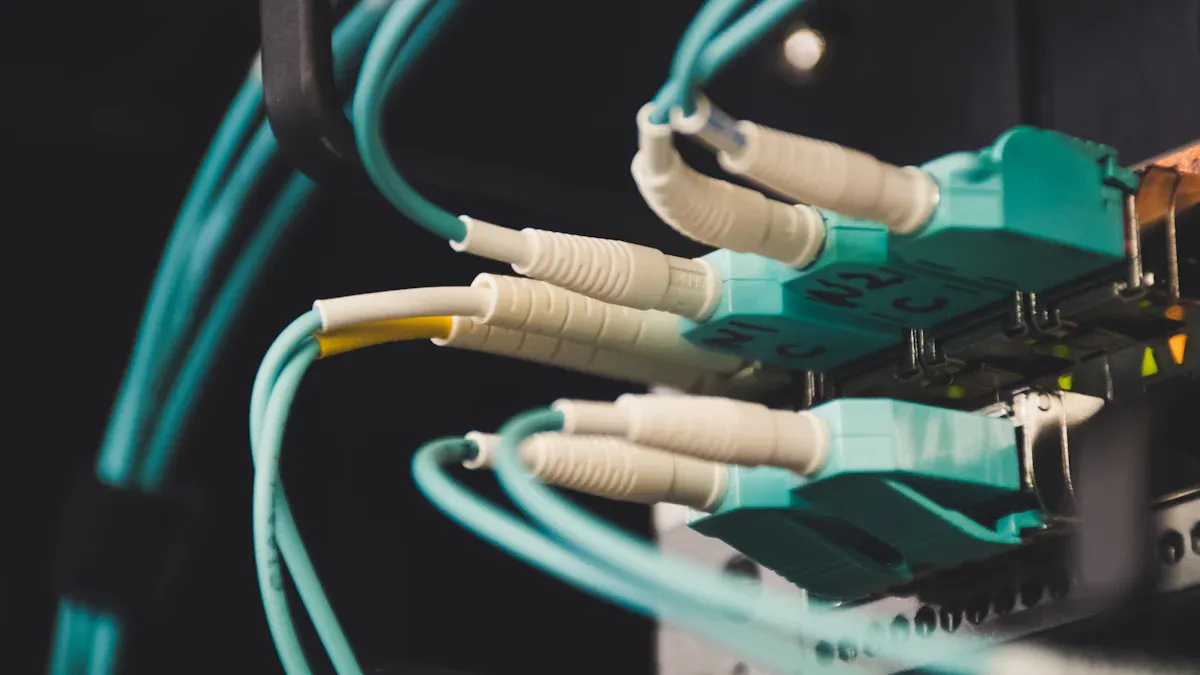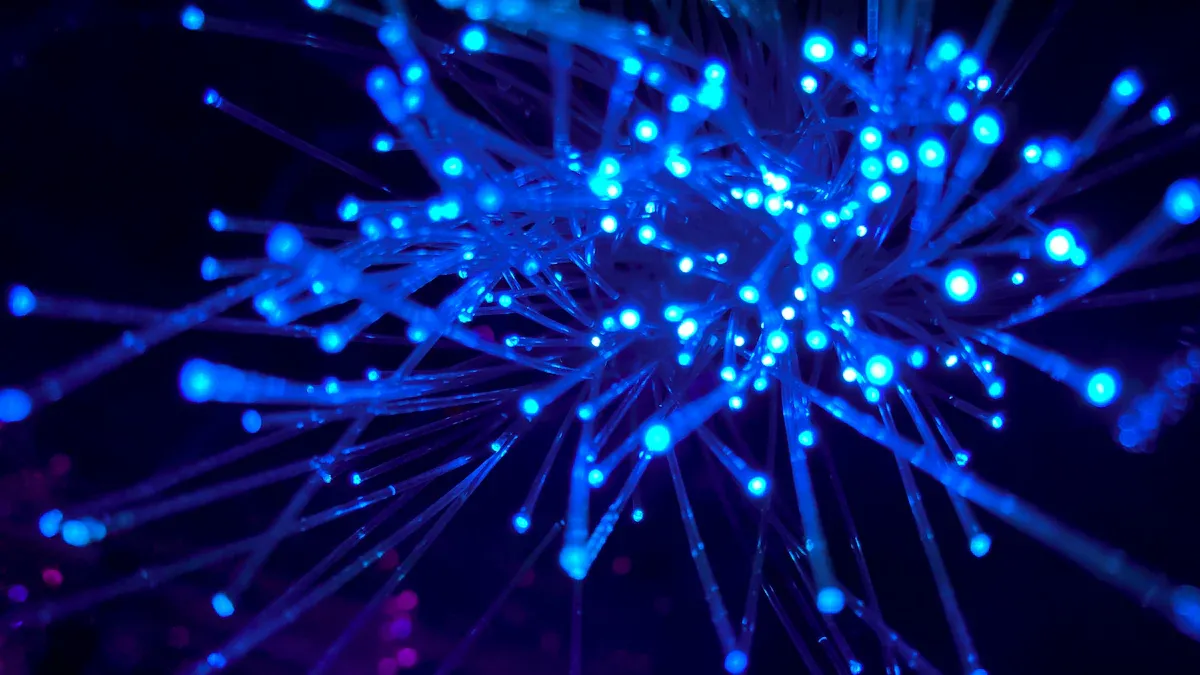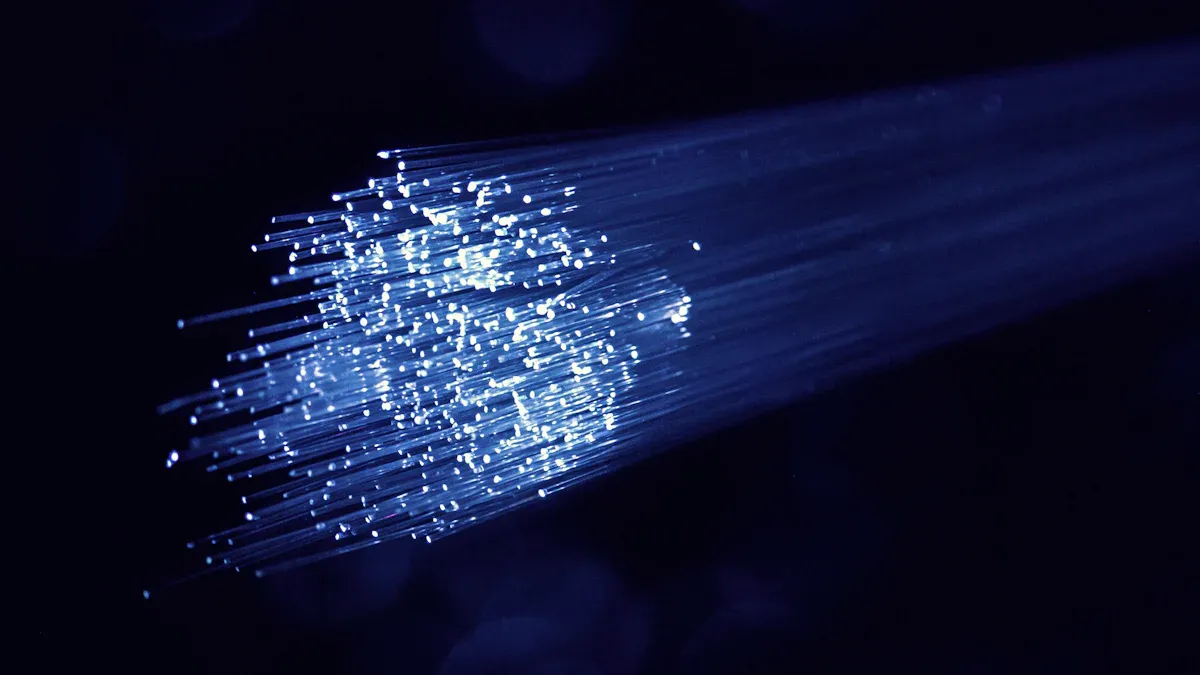Breakthroughs in Communication Cable Design and Performance

Global telecom networks have reached new heights in 2025 as communication cable advancements transform connectivity. Industry leaders now use innovative materials that boost speed and reliability. New technology, such as digital twin systems, helps monitor cable health in real time. Telecom providers invest in aerial and submarine cables, supporting the expansion of 5G and other high-speed services. These advancements create sustainable solutions that power the future of connectivity and technology.
Key Takeaways
New cable designs like ultra-low-loss fiber and miniature coaxial cables boost internet speed and reliability.
Advanced shielding protects cables from damage and interference, making networks more durable and stable.
Embedded sensors and digital twin technology help monitor cable health in real time, reducing downtime and maintenance costs.
Telecom cables now support growing technologies like 5G, smart cities, and data centers with faster and more efficient connectivity.
Investing in these innovations helps companies build future-ready networks that meet rising demands for high-speed data.
Communication Cable Advancements

Ultra-Low-Loss Fiber
Telecom networks now rely on ultra-low-loss fiber to achieve unprecedented performance. Manufacturers have refined fiber design, using advanced glass compositions and coatings that minimize signal attenuation. Recent technical reports show that these fiber optic cables meet strict standards for attenuation and durability. For example, at 1550 nm, attenuation remains below 0.25 dB/km, ensuring reliable long-distance transmission. The following table summarizes key performance metrics for modern fiber:
Test Parameter | Standard | Frequency | Acceptance Criteria |
|---|---|---|---|
Attenuation (1310 nm) | ITU-T G.652 | Every 2 km | <0.35 dB/km |
Attenuation (1550 nm) | ITU-T G.652 | Every 2 km | <0.25 dB/km |
Mode field diameter | ITU-T G.652 | Every 2 km | 9.2 ± 0.4 μm |
Proof test | IEC 60793-1-30 | 100% | 100 kpsi survival |
Coating diameter | IEC 60793-1-20 | Continuous | 245 ± 5 μm |
Telecom cable manufacturers use Statistical Process Control and automated quality systems to maintain these standards. Multi-core fibers and expanded wavelength bands now support terabit-per-second data rates. Dense wavelength-division multiplexing and advanced modulation techniques, such as 16-QAM and 64-QAM, further increase capacity. These advancements enable fiber-to-the-home networks to deliver multi-gigabit speeds, supporting the rapid growth of high-speed internet infrastructure. Commercial deployments of XGS-PON and 25G/50G PON standards highlight the ongoing innovation in fiber optic cables.
Miniature Coaxial Cables
Miniature coaxial cables have become essential in modern telecom applications. Engineers have reduced cable diameter while maintaining high-frequency performance. This compact design allows for easier installation in dense environments, such as data centers and 5G base stations. The cables support high-speed data transmission with minimal signal loss, making them ideal for advanced telecom cable systems. Improved wire and cable compounds provide greater flexibility and resistance to environmental stress. These features ensure reliable operation in both indoor and outdoor settings.
Telecom providers now use miniature coaxial cables to connect antennas, sensors, and network equipment. The cables' small size reduces weight and space requirements, which is critical for aerial and submarine cable deployments. As a result, telecom cable infrastructure can expand rapidly to meet growing demand for broadband connectivity.
Advanced Shielding
Advanced shielding technologies protect communication cable systems from electromagnetic interference and physical damage. Manufacturers use multi-layered shielding materials, such as aluminum-polyester tapes and braided copper, to enhance signal integrity. These innovations improve the performance of both fiber and coaxial telecom cable products.
Recent advancements in cable compounds have increased resistance to moisture, UV radiation, and temperature extremes. This durability extends the lifespan of telecom cable installations, reducing maintenance costs and downtime. The use of advanced shielding also supports the integration of communication cable systems into harsh environments, including aerial and submarine applications.
Note: The aerial cables and accessories market is projected to grow at a CAGR of 13.4% from 2025 to 2032. This growth is driven by telecommunications upgrades, urbanization, and infrastructure development. The trefoil cable cleat market will also see a CAGR of 5–7% over the next five years, reflecting the rising need for cable management in communication applications.
Market Segment | CAGR (%) | Period | Key Drivers and Context |
|---|---|---|---|
Aerial Cables and Accessories | 13.4 | 2025 to 2032 | Telecommunications upgrades, broadband demand, urbanization, infrastructure development |
Trefoil Cable Cleat Market | 5 to 7 | Next 5 years | Infrastructure development, technological advancements, cable management needs in communication applications |
Telecom cable advancements in shielding and materials ensure that communication cable systems remain robust and efficient. These improvements support the expansion of telecom networks, enabling reliable data transmission across diverse environments.
Performance Upgrades
Signal Integrity
Telecom networks demand high signal integrity to deliver reliable data transmission. Engineers focus on advanced cable design to minimize interference and signal loss. The growth of 5G and the expansion of IoT devices drive the need for high-frequency connectors and robust materials. Modern telecom cables use liquid crystal polymers and high-temperature plastics to maintain signal quality, even as cables become smaller. These materials support the miniaturization trend without sacrificing performance.
A recent industry table highlights the factors influencing signal integrity:
Aspect | Details |
|---|---|
Market Drivers | 5G growth, IoT expansion, miniaturization |
Material Advancements | Liquid crystal polymers, high-temp plastics |
Signal Integrity Challenges | Miniaturization risks, need for sophisticated design |
Industry Standards | New miniature RF connector standards (2023) |
Impact | Improved performance, reduced signal losses |
Telecom manufacturers implement rigorous testing, including microwave and millimeter-wave design validation. These tests ensure that cables meet strict benchmarks for output power, frequency precision, and spurious-free dynamic range. For example, a 1.52 GHz output Digital Direct Frequency Synthesizer in 65nm CMOS technology achieved a wideband spurious-free dynamic range of 62 dBc and output power of -4.5 dBm. Real-time calibration techniques further improve dynamic performance and resistance to interference, which is critical for telecom and radar systems.
Durability
Durability remains a top priority for telecom cable infrastructure. Engineers select materials that withstand harsh environments, including temperature extremes, moisture, and UV exposure. Enhanced performance in durability comes from advanced manufacturing processes and lifecycle management. Sustaining engineering and new product introduction services help telecom providers maintain reliable networks over time.
Telecom cables now feature robust outer jackets and reinforced shielding. These improvements protect the internal fiber and coaxial elements from physical damage. The design of these cables ensures long-term stability, reducing maintenance needs and downtime. As telecom networks expand into aerial and submarine environments, durability standards become even more important. Providers rely on cables that deliver consistent bandwidth and performance, regardless of installation conditions.
Tip: Telecom companies should regularly assess cable health using predictive maintenance tools to maximize service life and network reliability.
Technological Advancements
Embedded Sensors
Modern communication cable systems now feature embedded sensors that transform how companies monitor and maintain infrastructure. These sensors collect real-time data on cable health, performance, and environmental conditions. Airlines such as Scandinavian Airlines and Boeing have adopted predictive maintenance platforms that rely on sensor data to reduce downtime and improve reliability. GE Aviation uses AI-powered systems to analyze sensor feedback, detecting abnormal patterns and predicting efficiency drops before failures occur. These advancements allow for early fault detection and performance tracking, which leads to safer and more energy efficient cabling solutions.
The integration of sensors with digital platforms enables:
Real-time condition assessment of critical components
Early detection of faults and performance issues
Predictive maintenance that minimizes service interruptions
Enhanced operational efficiency and cost savings
Technological advancements in AI and cloud-based platforms further support these solutions. Companies can now retrofit aging infrastructure with advanced sensor systems, extending the lifespan of existing assets and improving overall safety.
Seamless Installation
Seamless installation has become a priority as digital infrastructure expands. Cable manufacturers design products for easy integration into both new and legacy systems. This approach reduces installation time and labor costs, supporting rapid deployment of advanced networks. Digital twin technology plays a key role by providing real-time models of cable-supported infrastructure. These models help engineers plan installations, monitor cable health, and predict maintenance needs.
Digital twin systems address traditional monitoring challenges by managing scattered data and enabling real-time health assessments. A three-layer digital twin framework supports predictive maintenance, while integration with decision support systems improves asset management. The construction industry increasingly adopts this technology for infrastructure monitoring and maintenance, strengthening predictive strategies and risk mitigation.
Tip: Companies that invest in technological advancements such as embedded sensors and digital twin technology gain a competitive edge in deploying robust, future-ready infrastructure.
Connectivity and Applications

5G and 6G Support
5G networks have transformed global connectivity, enabling faster data transmission and lower latency. Telecom providers deploy advanced cabling solutions to support the massive bandwidth demands of 5G. These networks require robust infrastructure to deliver high-speed internet connection in urban and rural areas. Engineers design cables that handle the increased data loads and electromagnetic interference common in dense environments. As 6G research accelerates, next-generation solutions will further enhance communication networks, supporting applications such as autonomous vehicles and immersive virtual reality. The integration of IoT devices into 5G networks increases the need for reliable data transmission and seamless connectivity. Cable manufacturers continue to innovate, ensuring that infrastructure can support the evolution of wireless networks.
Data Centers
Modern data centers serve as the backbone of digital infrastructure. Operators rely on advanced cabling to maintain high-speed internet and uninterrupted data flow. These facilities require cables that support rapid transmission, high bandwidth, and minimal signal loss. Engineers use fiber optic and miniature coaxial cables to optimize performance and energy efficiency. Data centers process vast amounts of internet traffic, making reliable connectivity essential for cloud computing, streaming, and enterprise applications. The growth of IoT and 5G networks drives demand for scalable solutions that can adapt to changing workloads. Providers invest in next-generation solutions to future-proof their networks and ensure consistent data delivery.
Smart Cities
Urban development forecasts highlight the critical role of advanced cable technology in building smart city infrastructure. City planners integrate smart grids and intelligent transportation systems that depend on reliable communication networks. Notable initiatives, such as New York City's citywide fiber-optic network and Singapore's Smart Nation, demonstrate how high-speed internet and advanced cabling create connected, sustainable cities. The expansion of electric vehicle charging infrastructure also drives demand for innovative cable solutions. Governments and private partners invest in research, digital infrastructure, and sustainable transport networks to accelerate the adoption of next-generation solutions. Enhanced cable materials and integration with AI, IoT, and analytics improve performance, supporting the data-driven needs of modern cities.
Recent breakthroughs in communication cable design—such as ultra-low-loss fiber, advanced shielding, and embedded sensors—have set new standards for speed, reliability, and sustainability. These innovations drive the evolution of digital infrastructure and support the rapid adoption of 5G, smart cities, and data-driven industries.
Enhanced bandwidth, low latency, and cost-effective manufacturing fuel strong market growth.
Global investments and regulatory support accelerate fiber optic network deployment.
Emerging technologies like edge computing and immersive media increase demand for ultra-fast networks.
Historical data shows steady growth in audiovisual cables, with projections reaching $6.5 billion by 2031.
Experts highlight that ongoing advancements and expanding applications across industries will continue to shape the future of connectivity.
Staying informed about cable technology innovations ensures organizations remain competitive in a rapidly evolving digital landscape.
FAQ
What are ultra-low-loss fiber cables?
Ultra-low-loss fiber cables use advanced glass and coatings to reduce signal loss. These cables support long-distance, high-speed data transmission. Telecom providers choose them for reliable internet and network performance.
How do embedded sensors improve cable maintenance?
Embedded sensors monitor cable health in real time. They detect faults and predict failures before they happen. This technology helps companies reduce downtime and extend cable lifespan.
Why is advanced shielding important in communication cables?
Advanced shielding protects cables from electromagnetic interference and physical damage. It ensures stable signal quality and extends cable durability. Engineers use materials like aluminum-polyester tape and braided copper for effective shielding.
How does digital twin technology benefit cable infrastructure?
Digital twin technology creates virtual models of cable systems. Engineers use these models to monitor performance, plan maintenance, and predict issues. This approach improves reliability and reduces operational costs.
Which industries benefit most from new cable technologies?
Industries such as telecommunications, data centers, and smart cities gain the most. These sectors require fast, reliable, and scalable connectivity. New cable technologies support their growth and innovation.
See Also
Understanding How Wires Differ From Cables In Telecom Cabinets
The Importance Of Upgrading Telecom Cabinets By The Year 2025
Complete Handbook For Wiring And Choosing Cables In Telecom Cabinets
The Vital Role Of Outdoor Cabinets In Today’s Telecom Networks
Analyzing Telecom Cabinet Designs And Their Associated Expenses
CALL US DIRECTLY
86-13752765943
3A-8, SHUIWAN 1979 SQUARE (PHASE II), NO.111, TAIZI ROAD,SHUIWAN COMMUNITY, ZHAOSHANG STREET, NANSHAN DISTRICT, SHENZHEN, GUANGDONG, CHINA

